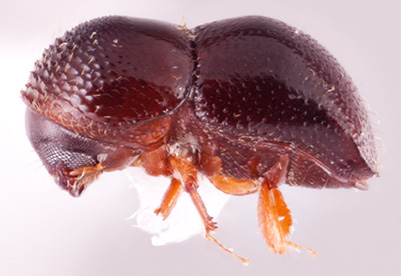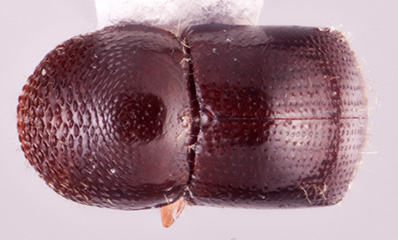Xylosandrus morigerus
|
Xylosandrus morigerus lateral; R.K. Osborn |
|
Xylosandrus morigerus dorsal; R.K. Osborn |
|
Xylosandrus morigerus declivity; R.K. Osborn |
|
Xylosandrus morigerus frontal; R.K. Osborn |
Taxonomic history
Xyleborus morigerus Blandford, 1894a: 264.
Xylosandrus morigerus (Blandford): Reitter, 1913: 84.
Synonyms
Xyleborus coffeae Wurth, 1908: 64. Strohmeyer, 1910: 86; Schedl, 1951b: 136.
Xyleborus difficilis Eggers, 1923: 174. Bright and Skidmore, 1997: 4, 169.
Xyleborus luzonicus Eggers, 1923: 174. Wood, 1974: 287.
Xyleborus abruptoides Schedl, 1955a: 298. Beaver, 1995b: 17.
Diagnosis
1.4−2.0 mm long (mean = 1.82 mm; n = 5); 2.0−2.33 times as long as wide. This species can be distinguished by its small size; elytral discdisc:
the flat central upper surface of any body part (e.g. pronotum and elytra)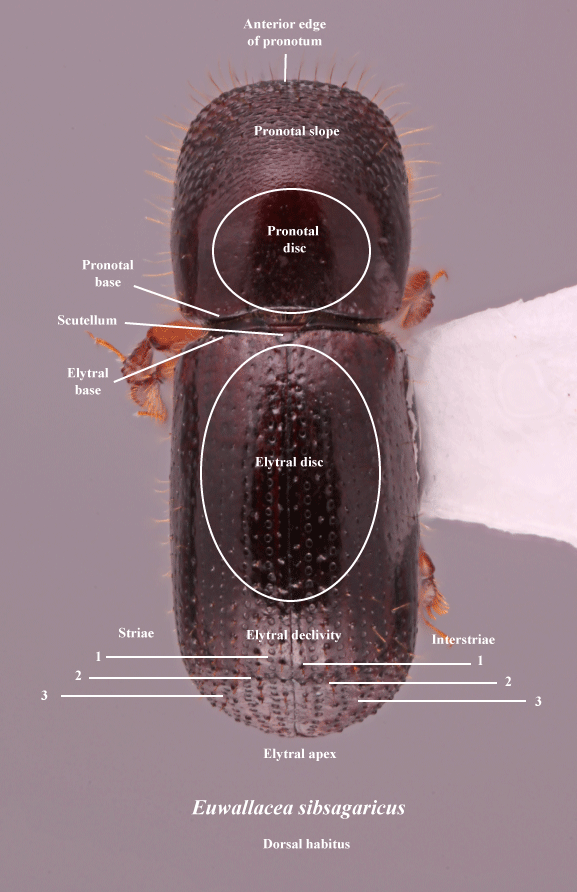 strongly convexconvex:
strongly convexconvex:
appearing rounded , much shorter than declivitydeclivity:
, much shorter than declivitydeclivity:
downward slope of either the pronotum or elytra
 ; posterolateralposterolateral:
; posterolateralposterolateral:
'relating to end of the side part/portion
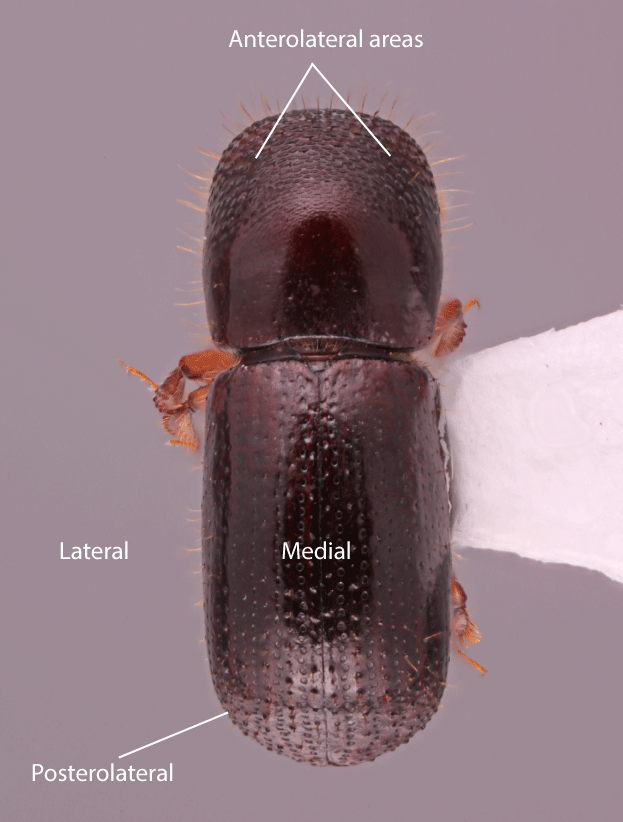 margins of elytraelytron:
margins of elytraelytron:
'
the two sclerotized forewings of beetles that protect and cover the flight wings
carinate to interstriaeinterstria:
'longitudinal spaces along the elytra between the striae, which is not as<br />
impressed and bear smaller punctures.
 7; declivitaldeclivital:
7; declivitaldeclivital:
pertaining to the elytral declivity
face with six punctate striae; declivitaldeclivital:
pertaining to the elytral declivity
striae setose, setaeseta:
small hair-like or scale-like structure
minute semi-recumbentsemi-recumbent:
pertaining to setae that are in between'erect and recumbent, usually at a 45 degree angle hairs; interstriaeinterstria:
hairs; interstriaeinterstria:
'longitudinal spaces along the elytra between the striae, which is not as<br />
impressed and bear smaller punctures.
 granulategranulate:
granulategranulate:
'pertaining to a coarse, grainy surface texture'
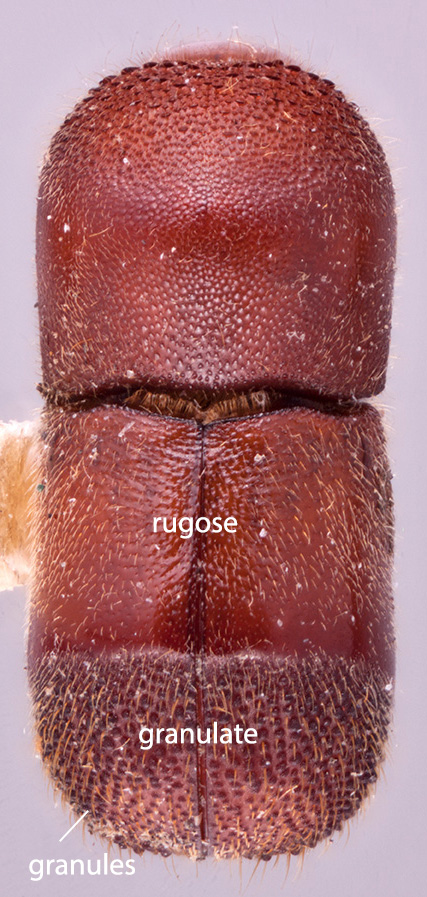 , uniseriate with erecterect:
, uniseriate with erecterect:
'pertaining to setae that have their apices directed away from the body and appear straight
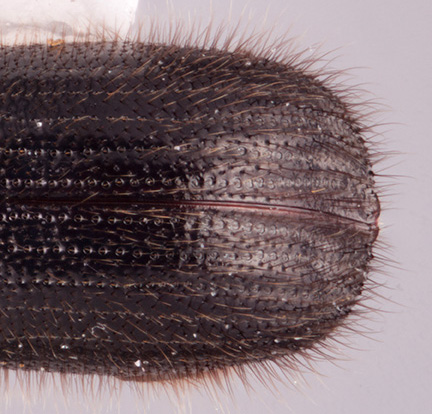 hair-like setaeseta:
hair-like setaeseta:
small hair-like or scale-like structure
longer than the width of one interstriainterstria:
'longitudinal spaces along the elytra between the striae, which is not as<br />
impressed and bear smaller punctures.
 ; pronotumpronotum:
; pronotumpronotum:
'the dorsal surface of the thorax
wider than long, from dorsaldorsal:
'of or relating to the upper surface; opposite of ventral
 view rounded (type 1) and laterallateral:
view rounded (type 1) and laterallateral:
'pertaining to the side
 view rounded (type 1), summitsummit:
view rounded (type 1), summitsummit:
highest point, used for pronotum and elytra, denotes the peak between pronotal frontal slope and disc, and between elytral disc and declivity at midpoint, basalbase:
at midpoint, basalbase:
point or edge closest to the body; opposite of apex half smooth, shiningshining:
half smooth, shiningshining:
appearing glossy or bright in luster; referring to a surface that is polished and reflects light well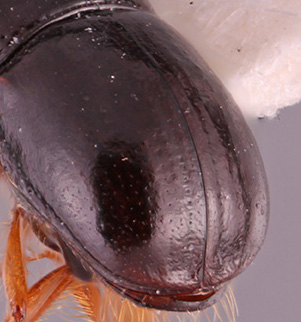 , sparsely minutely punctatepunctate:
, sparsely minutely punctatepunctate:
'set with fine impressed points, appearing as pin pricks
 ; and sparse mycangial tuftmycangial tuft:
; and sparse mycangial tuftmycangial tuft:
'tuft of setae that denotes the mycangia exterior opening
 on the pronotalpronotal:
on the pronotalpronotal:
'pertaining to the pronotum
basebase:
point or edge closest to the body; opposite of apex .
.
May be confused with
Xylosandrus adherescens, X. compactus, X. derupteterminatus, and X. mesuae
Distribution
Circumtropical. Within the study region recorded from China (Yunnan), India (Tamil Nadu, West Bengal), Laos, Myanmar, Taiwan, Thailand, Vietnam. Introduced to Europe (Kirkendall and Faccoli 2010Kirkendall and Faccoli 2010:
Kirkendall LR, Faccoli M. 2010. Bark beetles and pinhole borers (Curculionidae, Scolytinae, Platypodinae) alien to Europe. ZooKeys 56: 227-251. https://doi.org/10.3897/zookeys.56.529) and South and Central America (Wood 1982Wood 1982:
Wood SL. 1982. The bark and ambrosia beetles of North and Central America (Coleoptera: Scolytidae), a taxonomic monograph. Great Basin Naturalist Memoirs 8: 1-1359., 2007).
Host plants
strongly polyphagous (Dole and Cognato 2010Dole and Cognato 2010:
Dole SA, Cognato AI, 2010. Revision of Xylosandrus Reitter (Curculionidae: Scolytinae). Proceedings of the California of Science 61: 451-545.)
Remarks
The biology has been studied by Browne (1961a) and Kalshoven (1961). These and other studies are reviewed by Schedl (1963a) and Le Pelley (1968). The species has some economic importance as a pest of coffee (Kalshoven 1961Kalshoven 1961:
Kalshoven LGE. 1961. A study of the twig borer Xyleborus morigerus Blandford, mainly based on observations in Java. Tijdschrift voor Entomologie 104: 93-110., Le Pelley 1968Le Pelley 1968:
Le Pelley RH. 1968. Pests of coffee. London and Harlow, UK: Longmans, Green and Co. Ltd.) and of other crop trees.
DNA data
Sequences available for COI and CAD.

